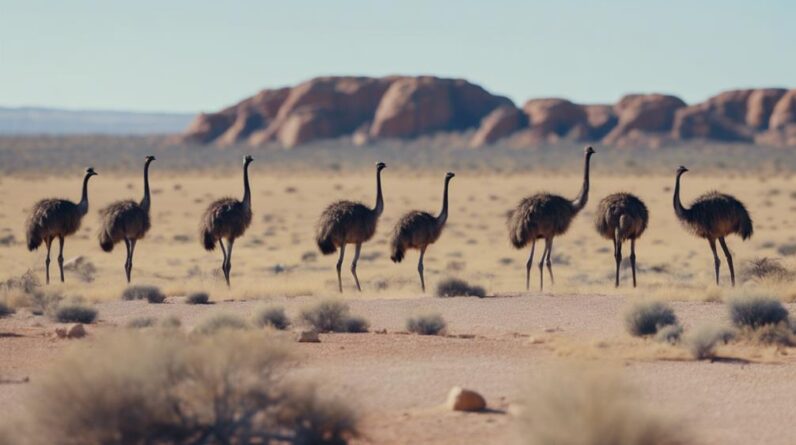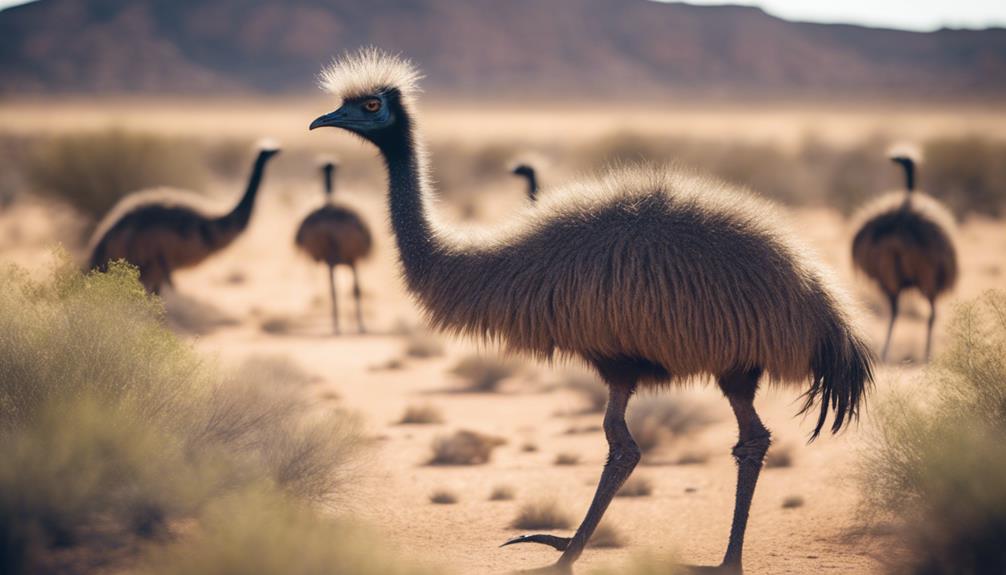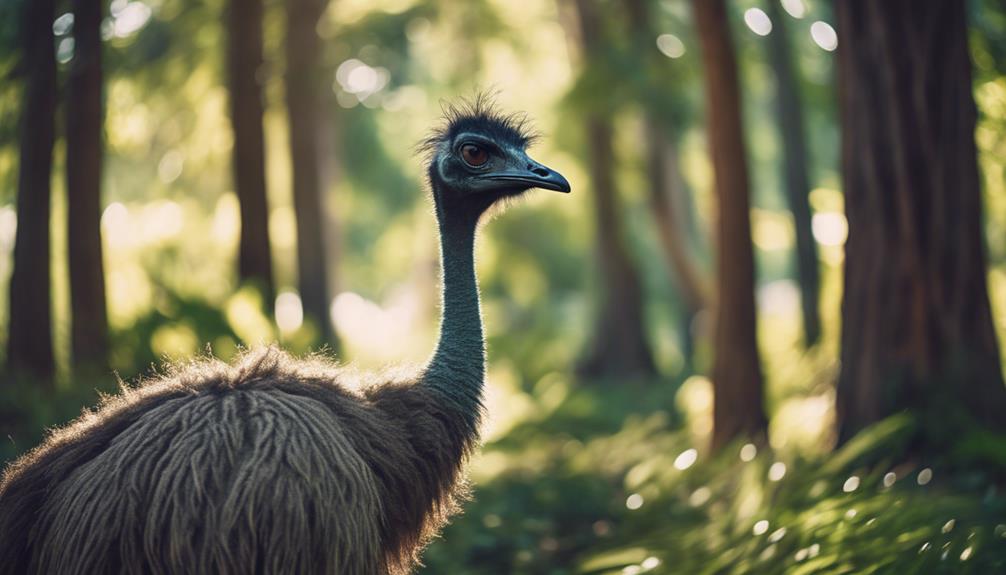
Imagine a world where emus roam like elusive shadows, perfectly adapted to their surroundings. Emus, with their intriguing habits and specialized features, hold secrets that unfold in the diverse tapestry of their natural habitats. From the arid outback to the fertile coastal plains, these enigmatic birds navigate a spectrum of ecosystems with grace and resilience. Understanding their connection to these environments unveils a fascinating story of survival and coexistence.
Key Takeaways
- Emus thrive in open woodlands, savannas, and grasslands.
- They avoid dense forests, urban areas, and mountainous regions.
- Emus adapt well to agricultural landscapes and semi-arid plains.
- Moderate temperatures are preferred for optimal survival.
- They inhabit woodlands, scrublands, heathlands, and coastal dunes.
Emus: An Overview

Emus inhabit various regions across Australia, displaying unique physical characteristics and behaviors that distinguish them as fascinating flightless birds. Standing tall at around 5 to 6.5 feet, these majestic creatures possess long necks and legs adapted for running at speeds of up to 30 miles per hour. Their bodies are covered in shaggy, gray-brown feathers that help regulate body temperature in the harsh Australian climate.
One of the most striking features of emus is their large, powerful legs, ending in three-toed feet equipped with sharp claws. These legs enable emus to traverse vast distances in search of food, which mainly consists of plants, fruits, insects, and small vertebrates. Despite their inability to fly, emus have adapted to their environment by being excellent swimmers when necessary, using their strong legs to propel themselves through water.
Observing emus in their natural habitat reveals a complex social structure within their groups, where dominant individuals establish hierarchy through displays of aggression and vocalizations. These behaviors contribute to the overall survival and success of the emu population in the Australian wilderness.
Emu Distribution
Across the vast continent of Australia, the distribution of emus spans various ecosystems and regions, reflecting their adaptability to diverse environments. Emus are most commonly found in mainland Australia, from the rainforests of Queensland to the arid deserts of the Outback. They're also present in parts of Tasmania. Emus tend to favor open woodlands, savannas, grasslands, and coastal regions. Their ability to thrive in such a wide range of habitats is a testament to their resilience and resourcefulness.
In Australia, emus are notably absent from dense forests, urban areas, and the more mountainous regions. They're often seen roaming the semi-arid and arid plains, using their strong legs to cover large distances in search of food and water. Emus have even adapted to agricultural landscapes, occasionally venturing into farmlands and pastures. Despite their widespread distribution, emus are known to avoid extremely hot or cold environments, preferring moderate temperatures for optimal survival. Their distribution patterns reflect their evolutionary history and ability to navigate through diverse terrains.
Emu Habitat Types

In exploring the varied habitats favored by emus in Australia, one can observe a range of ecosystem types where these resilient birds thrive. Emus are adaptable creatures, found in diverse environments such as woodlands, scrublands, heathlands, and coastal dunes. Woodlands provide emus with ample food sources like fruits, seeds, and insects while offering some protection from predators with their dense vegetation.
Scrublands, characterized by shrubby plants, offer emus cover and foraging opportunities. Heathlands, with their low-lying vegetation and sandy soils, are also suitable habitats for emus to roam freely.
Emus can often be spotted in coastal dunes, where they navigate the sandy terrain with ease, feeding on a variety of plant species that grow in this unique ecosystem. These birds show remarkable adaptability to different habitat types, utilizing their keen senses and agile bodies to thrive in these challenging environments.
Understanding the diverse habitats where emus reside is crucial for conservation efforts and ensuring the continued success of these remarkable birds in the wild.
Grasslands and Emus
Amidst the vast expanses of Australia's grasslands, the interactions between native wildlife and their environment reveal fascinating insights into the ecological dynamics at play. Emus, the largest birds native to Australia, are intricately woven into the tapestry of these grasslands. Their long legs and powerful toes are adapted to traverse the uneven terrain with ease, allowing them to roam vast distances in search of food and water.
In the grasslands, emus predominantly feed on a variety of plant species, including grasses, seeds, and fruits. Their foraging behavior not only shapes the vegetation composition but also influences nutrient cycling in the ecosystem. By consuming a diverse array of plants, emus play a crucial role in maintaining the balance of the grassland ecosystem.
These flightless birds are also integral to the grassland food web, serving as both predators and prey. Their presence regulates insect populations, while their eggs and young are targeted by predators such as dingoes and eagles. Emus' adaptability to the open grasslands underscores their significance in this unique habitat, highlighting the intricate relationship between these majestic birds and their environment.
Emus in Forests

Emus' behavior shifts when they navigate the dense canopies and diverse undergrowth of forest habitats, adapting their foraging strategies to the new array of plant species available to them. In forests, emus display a keen sense of curiosity, often pecking at various vegetation to discern palatability. Their typical grazing behavior transitions into a more selective feeding pattern, focusing on berries, seeds, and tender shoots found in this lush environment. Emus exhibit a heightened awareness in forests, utilizing their sharp eyesight to scan the surroundings for both food and potential threats.
These tall, flightless birds move gracefully among the trees, their strong legs propelling them through the underbrush with surprising agility. The forest floor provides ample opportunities for emus to scratch and dig for hidden delicacies, showcasing their resourcefulness in accessing otherwise inaccessible food sources. Despite the challenges posed by the intricate terrain, emus navigate the forest with confidence, their movements purposeful and deliberate. The forest habitat offers a rich tapestry of flavors and textures for emus to explore, highlighting their adaptability in diverse ecosystems.
Wetlands and Emus
Exploring the wetlands reveals a diverse and dynamic environment that presents unique challenges and opportunities for emus. These vast, marshy areas provide rich feeding grounds for emus, offering a variety of plant species such as sedges, rushes, and aquatic plants. Emus are well-adapted to traverse the muddy terrain with their long legs, allowing them to forage for food in the wetlands efficiently.
The wetlands also serve as important breeding grounds for emus, providing a safe and secluded environment for nesting. Emus construct their nests on the ground, hidden among the tall grasses and reeds, offering protection for their eggs and young chicks. The abundance of water sources in the wetlands ensures that emus have access to hydration, crucial for their survival in these habitats.
However, the wetlands can present challenges for emus, such as navigating through dense vegetation and avoiding potential predators lurking in the marshy areas. Despite these obstacles, emus have evolved remarkable adaptations to thrive in these dynamic and complex ecosystems, showcasing their resilience and adaptability as iconic inhabitants of the wetlands.
Desert Environments

In the arid expanse of desert environments, emus demonstrate remarkable adaptations to thrive in harsh conditions where resources are scarce and temperatures can be extreme. Emus in these environments have evolved specialized physiological and behavioral characteristics to endure the challenges presented by the desolate landscapes. Their ability to conserve water efficiently, withstand high temperatures, and locate scarce food sources showcases their resilience in the face of adversity.
—
| Desert Environment Challenges | Emu Adaptations |
|---|---|
| Limited water sources | Ability to go extended periods without drinking |
| Extreme temperatures | Efficient thermoregulation through behavioral adaptations |
| Scarcity of food | Excellent foraging skills to locate sparse vegetation |
| Predation risks | Exceptional eyesight and speed for predator evasion |
| Harsh terrain | Strong legs and powerful claws for navigating rugged landscapes |
—
Emus in Savannas
Thriving in the vast savannas, emus display a range of adaptive behaviors and physical characteristics that enable them to navigate and prosper in this dynamic ecosystem. Emus are well-suited to the savanna environment due to their long legs, which allow for efficient movement across the grassy plains. Their powerful muscles enable them to run at impressive speeds, essential for evading predators such as dingoes. Emus have also developed a keen sense of hearing, detecting potential threats from afar.
In savannas, emus often form small groups, providing protection and support to one another. Their diet primarily consists of grass, seeds, and insects, which are abundant in this habitat. Emus play a crucial role in seed dispersal, aiding in the regeneration of plant species across the savanna.
The savanna's seasonal changes pose challenges, but emus have evolved to adapt to these fluctuations. During dry seasons, they can go for extended periods without water, relying on their ability to extract moisture from their food. Emus in savannas exemplify the resilience and adaptability of these remarkable birds in the face of diverse environmental conditions.
Coastal Habitats

Emus along coastal habitats exhibit distinct behaviors and adaptations suited to the challenges of their marine-influenced environment. These majestic birds have evolved to thrive in the dynamic coastal zones, where they face unique conditions. The coastal emus are adept swimmers, using their powerful legs to navigate through shallow waters in search of food such as fish, crustaceans, and seaweed. Their feathers are designed to repel water, keeping them buoyant and warm in the cool ocean breeze.
In these habitats, emus display a heightened sense of alertness, constantly scanning the horizon for potential predators like foxes or seabirds. Their long necks allow them to reach vegetation in marshy areas, while their keen eyesight aids in detecting threats from afar. Coastal emus have also developed a specialized diet that includes salt-tolerant plants and fruits found along the shoreline.
Emus and Human Interaction
Human activities often intersect with the natural habitats of emus, leading to varied interactions between these majestic birds and people. When humans encroach upon emu territories, conflicts may arise. Emus, curious by nature, might approach humans out of interest or in search of food. However, this behavior can sometimes result in negative encounters, especially if emus feel threatened or provoked. In some cases, emus have been known to peck or kick humans who invade their space.
On the other hand, humans also impact emus positively through conservation efforts and eco-tourism initiatives. By protecting emu habitats and educating the public about these birds, humans can foster a harmonious relationship with emus. It's essential for individuals to respect the boundaries of these wild creatures and appreciate them from a distance to ensure the well-being of both emus and humans in their shared environments.
Threats to Emu Habitats

In the vast expanse of emu habitats, encroachment by human activities poses significant threats to the survival of these majestic birds and the delicate balance of their ecosystems. Urbanization and infrastructure development lead to habitat fragmentation, disrupting emus' natural movements and breeding patterns. Deforestation for agriculture and logging diminishes the availability of food sources and shelter for emus. The introduction of invasive species competes with emus for resources, further straining their habitats.
Pollution from industrial activities and waste disposal contaminates water sources, affecting both emus and their prey. Climate change brings about extreme weather events, altering the landscape and reducing food availability. Overhunting and poaching also contribute to the decline in emu populations and disrupt the ecosystem dynamics.
Understanding these threats is crucial in devising effective conservation strategies to protect emu habitats and ensure the long-term survival of these remarkable birds. By addressing these challenges through sustainable practices and habitat restoration efforts, we can safeguard the future of emus and preserve the biodiversity of their natural environments.
Conservation Efforts
Encroachment by human activities has prompted the implementation of various conservation efforts aimed at safeguarding the delicate balance of emu habitats and preserving their ecosystems. To effectively protect emus and their natural habitats, conservation strategies have been put in place. These efforts include habitat restoration, predator control programs, public awareness campaigns, and research initiatives to better understand emu behavior and habitat requirements.
| Conservation Efforts | Description | Impact |
|---|---|---|
| Habitat Restoration | Reintroduction of native vegetation | Restores natural emu feeding grounds |
| Predator Control | Monitoring and management of predators | Reduces predation on emu populations |
| Public Awareness | Education on preserving emu habitats | Promotes conservation efforts |
| Research Initiatives | Studying emu behavior and needs | Informs targeted conservation strategies |
Through these conservation efforts, the balance of emu habitats can be maintained, ensuring the continued existence of these majestic birds in their natural ecosystems. By actively participating in these initiatives, we can contribute to the preservation of emus and the biodiversity of their habitats.
Frequently Asked Questions
Do Emus Migrate Between Different Habitat Types?
Emus do not migrate between different habitat types. They tend to remain within their established territories due to territorial behavior and strong fidelity to their home range, ensuring they stay within familiar and preferred environments.
How Do Emus Protect Themselves From Predators?
You, emus protect yourselves by becoming ninja-like masters of stealth. Your feathers blend seamlessly with the environment, and your swift legs can outrun most predators. With sharp eyesight and quick reflexes, you are nature's ultimate escape artist.
What Is the Average Lifespan of an Emu?
Emus typically live for about 10 to 20 years in the wild. This lifespan can vary due to factors such as predation, disease, and environmental conditions. Emus face challenges that impact their longevity.
Are Emus Territorial and Aggressive Towards Other Species?
You might find that emus are territorial and aggressive towards other species. Their behavior can be likened to a vigilant sentinel fiercely guarding its domain. Understanding this aspect of emus is crucial in respecting their space.
How Do Emus Adapt to Changing Environmental Conditions?
Emus adapt to changing environmental conditions by modifying their behavior, such as altering foraging patterns or seeking out new water sources. They also adjust their breeding seasons and nest locations to optimize survival in challenging habitats.
Conclusion
In conclusion, emus play a crucial role in maintaining the health of various ecosystems in Australia.
For example, in the grasslands, emus help control vegetation growth by feeding on grasses and plants, preventing overgrowth and promoting biodiversity.
By understanding the importance of emus in their natural habitats and implementing conservation efforts to protect them, we can ensure the long-term sustainability of these ecosystems and the species that rely on them.





